 This chilled soup is ideal for a summer meal, and a sure way to impress any guest. This is the gazpacho that blew my mind in Madrid when we first visited a few years ago — with a smooth, creamy, velvety consistency, but without any animal-based products at all. The recipe comes from Cook’s Illustrated. While the folks at America’s Test Kitchen often seem to needlessly complicate some standard recipes, this one is well worth the small additional effort to prepare the vegetables. Continue reading
This chilled soup is ideal for a summer meal, and a sure way to impress any guest. This is the gazpacho that blew my mind in Madrid when we first visited a few years ago — with a smooth, creamy, velvety consistency, but without any animal-based products at all. The recipe comes from Cook’s Illustrated. While the folks at America’s Test Kitchen often seem to needlessly complicate some standard recipes, this one is well worth the small additional effort to prepare the vegetables. Continue reading
Category Archives: Salads and Sides
Farro and Asparagus Salad
 Recently while looking for a new idea for a refreshing but substantial salad to serve for Easter brunch, we found this gem on Allrecipes.com. We liked it so much that we served it two more times within a month. Once we substituted barley for the farro with excellent results. The other time, we replaced the asparagus with fresh steamed green beans, which were delightful. Continue reading
Recently while looking for a new idea for a refreshing but substantial salad to serve for Easter brunch, we found this gem on Allrecipes.com. We liked it so much that we served it two more times within a month. Once we substituted barley for the farro with excellent results. The other time, we replaced the asparagus with fresh steamed green beans, which were delightful. Continue reading
Couscous Salad with Roasted Vegetables and Chickpeas
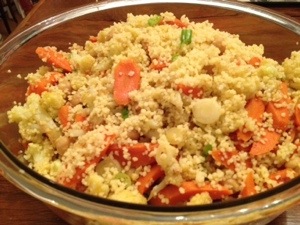 Looking for an easy and healthful lunch for the home or office? This is one of my favorite recipes — and it’s totally vegan. It comes from the January 2008 issue of Martha Stewart’s Everyday Food magazine and was also featured on the Today show. It’s infinitely variable; if you don’t happen to have cauliflower on hand, you can substitute another vegetable that roasts well, like bell peppers, or eggplant, or zucchini, or sliced onion. I like including whole garlic cloves. The arugula is nice, but totally optional. And when I made this dish for lunch today, I substituted quinoa for the couscous, and it works perfectly! Feel free to vary this to your own taste, and enjoy. Continue reading
Looking for an easy and healthful lunch for the home or office? This is one of my favorite recipes — and it’s totally vegan. It comes from the January 2008 issue of Martha Stewart’s Everyday Food magazine and was also featured on the Today show. It’s infinitely variable; if you don’t happen to have cauliflower on hand, you can substitute another vegetable that roasts well, like bell peppers, or eggplant, or zucchini, or sliced onion. I like including whole garlic cloves. The arugula is nice, but totally optional. And when I made this dish for lunch today, I substituted quinoa for the couscous, and it works perfectly! Feel free to vary this to your own taste, and enjoy. Continue reading
Charkhlis Mkhali (Georgian Beet Salad)
 The Georgian table is always filled with a vast array of salads and appetizers. Often at a Georgian restaurant, I don’t even make it to the main dish because I stuff myself on starters. This is one of the culprits. Mkhali (or pkhali) is a general term for a vegetable puree mixed with herbs and ground walnuts. Yesterday I made the version with beets. You could just as easily substitute spinach or other greens. This recipe comes almost verbatim from Darra Goldstein’s masterpiece The Georgian Feast: The Vibrant Culture and Savory Food of the Republic of Georgia, one of my all-time favorite cookbooks. Continue reading
The Georgian table is always filled with a vast array of salads and appetizers. Often at a Georgian restaurant, I don’t even make it to the main dish because I stuff myself on starters. This is one of the culprits. Mkhali (or pkhali) is a general term for a vegetable puree mixed with herbs and ground walnuts. Yesterday I made the version with beets. You could just as easily substitute spinach or other greens. This recipe comes almost verbatim from Darra Goldstein’s masterpiece The Georgian Feast: The Vibrant Culture and Savory Food of the Republic of Georgia, one of my all-time favorite cookbooks. Continue reading
Lobio (Georgian bean salad)
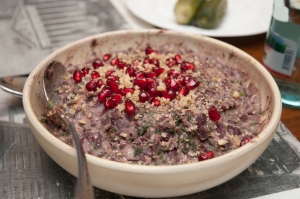 Along with generous amounts of khachapuri, the other item that I almost always order in a Georgian restaurant is lobio. It comes different ways. This particular recipe is fairly standard. This recipe is a perfect example of how the Georgians can take something as ordinary as kidney beans and turn them into something wondrously exotic. If your friends are deathly allergic to walnuts, you can leave them out, and the dish doesn’t suffer too much. This dish can be served either at room temperature or hot. The hot version usually has the consistency of a stew and is often made with hot pepper. Continue reading
Along with generous amounts of khachapuri, the other item that I almost always order in a Georgian restaurant is lobio. It comes different ways. This particular recipe is fairly standard. This recipe is a perfect example of how the Georgians can take something as ordinary as kidney beans and turn them into something wondrously exotic. If your friends are deathly allergic to walnuts, you can leave them out, and the dish doesn’t suffer too much. This dish can be served either at room temperature or hot. The hot version usually has the consistency of a stew and is often made with hot pepper. Continue reading
Khachapuri / ხაჭაპური (Georgian cheese bread)
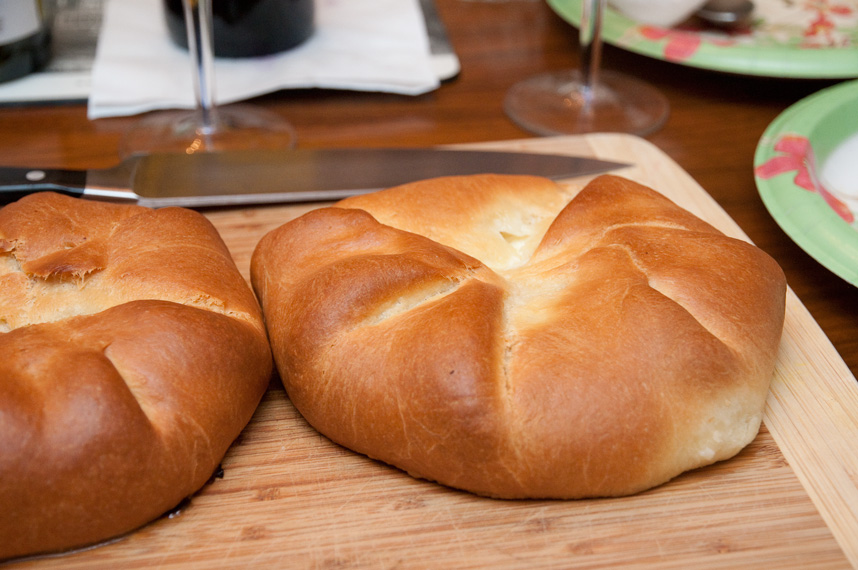
Khachapuri is a staple food in Georgia. It is so standard throughout the Caucasus nation that the economics school at Tbilisi State University has developed a “khachapuri index” to measure Georgian inflation, using as its market basket the set of ingredients used to make khachapuri, including the energy to power the oven.
Each of the country’s several regions has its own distinct style. Imeretian khachapuri, the most common, is circular and filled with cheese. Mingrelian is similar, but with more cheese added on top. Ossetian has potato in the filling. Adjarian is shaped like an open boat and topped with a raw egg that is stirred into the cheese filling before eating. Abkhazian (achma) is made of multiple moist layers of pasta-like dough, like Serbian gibanica or a dry lasagna.
This recipe is a combination of the dough used in Darra Goldstein’s recipe in The Georgian Feast (my favorite Georgian cookbook) and my favorite filling from Anya von Bremzen’s recipe in Please to the Table. The picture above is what I produced in 2013. It was very good, though not exactly the most common look.
Continue readingYellow Lentils (Dal Tadka)
 Last weekend my wife and I went out to dinner with a friend from college to Bollywood Bistro, a fun Indian establishment in old-town Fairfax, Virginia. The service was enthusiastic (if a bit overbearing with the water-glass refills). And one of my favorite dishes was the yellow dal, which is a very common dish in Indian cuisine. I was inspired to try it myself the next evening at home, and it was quite satisfying. I started with a popular recipe from Ruta Kahate’s book 5 Spices, 50 Dishes: Simple Indian Recipes Using Five Common Spices, and adjusted it to my available ingredients and cooking preferences. I came up with the recipe below.
Last weekend my wife and I went out to dinner with a friend from college to Bollywood Bistro, a fun Indian establishment in old-town Fairfax, Virginia. The service was enthusiastic (if a bit overbearing with the water-glass refills). And one of my favorite dishes was the yellow dal, which is a very common dish in Indian cuisine. I was inspired to try it myself the next evening at home, and it was quite satisfying. I started with a popular recipe from Ruta Kahate’s book 5 Spices, 50 Dishes: Simple Indian Recipes Using Five Common Spices, and adjusted it to my available ingredients and cooking preferences. I came up with the recipe below.
A note for those who appreciate the health benefits of herbs: Indian cuisine is filled with turmeric, which has potent anti-inflammatory effects when used in generous quantities. It has also been shown to have some anti-cancer effect, and researchers are also investigating its possible effectiveness in Alzheimer’s disease. To maximize its bio-availability, it needs to be combined with black pepper, which works synergistically with turmeric’s most active constituent, curcumin. Hence, I’ve added black pepper to this recipe. Enjoy this tasty opportunity to contribute to science! Continue reading
Olivier Salad (Салат Оливье)
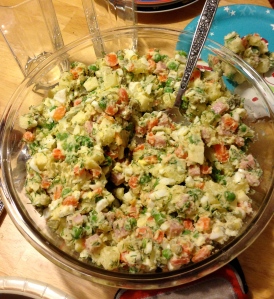 This is quintessential Russian salad, and an indispensable part of every New Year’s Eve table. Since my first visit to Russia in 1987, I can remember being served this salad in various forms and combinations. On New Year’s Eve 2012, we decided to make it for friends, and I searched my Russian cookbooks for a recipe. Inevitably, Anya von Bremzen, in her classic Please to the Table, included a quirky variation from her childhood, made with shredded cabbage, which bears no resemblance to any salat oliviye I’ve ever tasted. The version from the Russian-language cookbook had no measurements — because what self-respecting Russian housewife would ever write down the amount of peas, carrots, ham, potatoes, and eggs she uses in a salad? So I improvised based on the ingredients I remembered, and this version came out pretty well. When I try it again, I might use a little less potato. Continue reading
This is quintessential Russian salad, and an indispensable part of every New Year’s Eve table. Since my first visit to Russia in 1987, I can remember being served this salad in various forms and combinations. On New Year’s Eve 2012, we decided to make it for friends, and I searched my Russian cookbooks for a recipe. Inevitably, Anya von Bremzen, in her classic Please to the Table, included a quirky variation from her childhood, made with shredded cabbage, which bears no resemblance to any salat oliviye I’ve ever tasted. The version from the Russian-language cookbook had no measurements — because what self-respecting Russian housewife would ever write down the amount of peas, carrots, ham, potatoes, and eggs she uses in a salad? So I improvised based on the ingredients I remembered, and this version came out pretty well. When I try it again, I might use a little less potato. Continue reading
Chipotle Shrimp Salad in Tortilla Cups
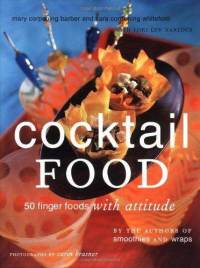 I found this recipe in Cocktail Food: 50 Finger Foods with Attitude, which we bought on a whim at the Williams-Sonoma outlet one day. (A fantastic book, by the way — highly recommended.) I made it in 2008 for an office party at the State Department, and it received rave reviews. We soon moved on to our new assignment in Moscow, and my wife wowed many of her catering customers with this recipe. When we returned to Washington in 2011, a colleague from the Department noticed my name on an e-mail and wrote to me, not having seen me in almost four years, and remembered the shrimp cups from that office party. Continue reading
I found this recipe in Cocktail Food: 50 Finger Foods with Attitude, which we bought on a whim at the Williams-Sonoma outlet one day. (A fantastic book, by the way — highly recommended.) I made it in 2008 for an office party at the State Department, and it received rave reviews. We soon moved on to our new assignment in Moscow, and my wife wowed many of her catering customers with this recipe. When we returned to Washington in 2011, a colleague from the Department noticed my name on an e-mail and wrote to me, not having seen me in almost four years, and remembered the shrimp cups from that office party. Continue reading
Spinach, Onion, and Feta Quiche
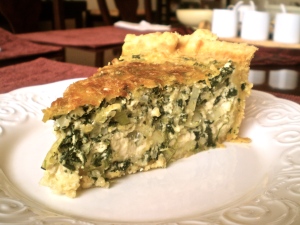 If you really want to impress your guests for Sunday brunch, this is it! I first found this recipe in an NPR article. On September 13, 2009, I had the time and a good excuse to make it. And it was unbelievably fabulous. I’m reprinting the recipe below exactly as it appeared, but with photos of my own result. Instead of the standard Quiche Lorraine, I decided to go for a meatless combination and substituted a mixture inspired by my wife’s family spanakopita recipe: 10 oz. of frozen spinach, thawed and with all water squeezed out; 2 medium-sized onions, chopped finely and sautéed in butter over medium-low heat for 20-30 minutes; a cup (or a little less) of crumbled feta cheese; 3 chopped scallions, and 2 teaspoons of oregano. I used this mixture in place of the bacon-onion combination in the original recipe, layering it inside the pre-baked crust together with the custard mixture and a cup of grated Emmentaler cheese. (The recipe calls for a half cup, but I doubled it because I like cheese.) Also, because I was a bit pressed for time, I didn’t chill it for eight hours after baking as the recipe recommends. But I didn’t notice that the end result was any less scrumptious. Continue reading
If you really want to impress your guests for Sunday brunch, this is it! I first found this recipe in an NPR article. On September 13, 2009, I had the time and a good excuse to make it. And it was unbelievably fabulous. I’m reprinting the recipe below exactly as it appeared, but with photos of my own result. Instead of the standard Quiche Lorraine, I decided to go for a meatless combination and substituted a mixture inspired by my wife’s family spanakopita recipe: 10 oz. of frozen spinach, thawed and with all water squeezed out; 2 medium-sized onions, chopped finely and sautéed in butter over medium-low heat for 20-30 minutes; a cup (or a little less) of crumbled feta cheese; 3 chopped scallions, and 2 teaspoons of oregano. I used this mixture in place of the bacon-onion combination in the original recipe, layering it inside the pre-baked crust together with the custard mixture and a cup of grated Emmentaler cheese. (The recipe calls for a half cup, but I doubled it because I like cheese.) Also, because I was a bit pressed for time, I didn’t chill it for eight hours after baking as the recipe recommends. But I didn’t notice that the end result was any less scrumptious. Continue reading
